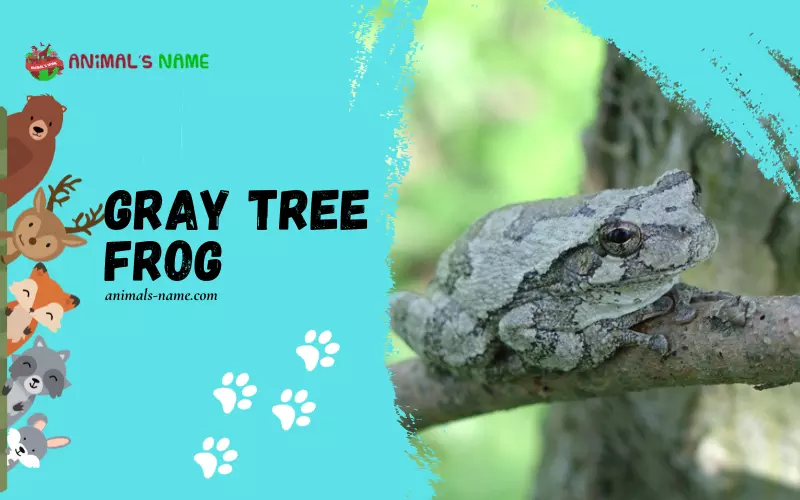The grey tree frog is a fascinating creature in various parts of North America. It has a rich history dates back many years and continues to capture the curiosity of animal enthusiasts. This blog post will delve into the history, facts, size, habitat, and classification of the grey tree frog, shedding light on this unique animal.
The grey tree frog is a small amphibian known for its remarkable ability to change its colour. These adorable creatures measure around 1.5 to 2 inches long, making them quite compact. They have specialized toe pads that allow them to cling to trees, hence their name. It’s truly fascinating how they blend in with the bark of trees to avoid predators.
Regarding their habitat, grey tree frogs are primarily found in forests, woodlands, and suburban areas across the United States and Canada. They are excellent climbers, often spotted on tree trunks, branches, or walls. These frogs are nocturnal, meaning they are most active at night, making distinctive calls that can be heard from afar.
History of Gray Tree Frog
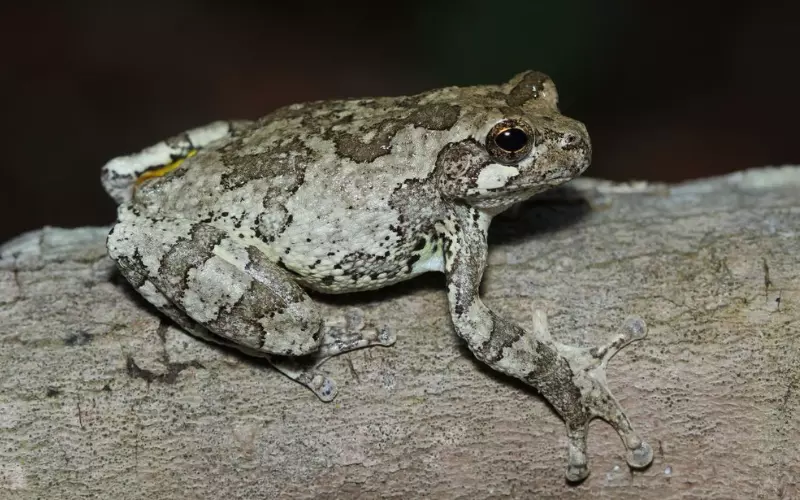
The grey tree frog is a fascinating creature with a rich history that dates back many years. These small amphibians can be found in various parts of North America, including Canada and the United States. They are known for their incredible ability to climb trees and blend in with their surroundings.
Grey tree frogs have been around for thousands of years, but it was not until the 18th century that scientists began to study and document these unique creatures. Through their research, scientists discovered that grey tree frogs go through metamorphosis, starting as tadpoles living in water and eventually developing into frogs that can live on land. This fascinating transformation has captivated the attention of many nature enthusiasts.
Over the years, the grey tree frog has become a beloved creature by many people, including those living where these frogs can be found. They are often admired for their beautiful grey and green colouration, a form of camouflage to hide from predators. The grey tree frog’s distinctive call, often described as a short trill or a soft musical note, can also be heard during the warmer months of the year.
The grey tree frog has a long and fascinating history that spans many years. From their unique ability to climb trees to their captivating metamorphosis process, these tiny amphibians continue to captivate the hearts and minds of those who encounter them. Whether it is their beautiful colours or their melodic calls, the grey tree frog is a remarkable creature worthy of admiration.
Importance of Gray Tree Frog

The grey tree frog is a critical animal in our environment. It plays a significant role in maintaining the balance of nature. Let’s find out why this little creature is so essential.
Firstly, the grey tree frog helps control insects. It loves to eat insects like mosquitoes and flies. Eating these pests helps keep their populations in check. This is great news for humans because mosquitoes can spread malaria and dengue fever. So, having grey tree frogs around can help reduce the number of these disease-carrying pests.
Secondly, the grey tree frog is a bioindicator. What does that mean? Well, this frog can tell us if our environment is healthy. The frogs can become sick or even die from environmental pollutants or toxins. So, by studying the health of these frogs, scientists can understand if any dangers exist in our ecosystem. This is crucial because it helps us take necessary actions to protect our environment and keep it safe for all living beings.
The grey tree frog is a remarkable creature that plays an essential role in our ecosystem. It helps control insect populations and serves as a warning sign if our environment is polluted. By protecting these little frogs, we are helping them and ensuring the well-being of our entire ecosystem. Let’s appreciate and take care of these critical animals!
Amazing Facts About Gray Tree Frog
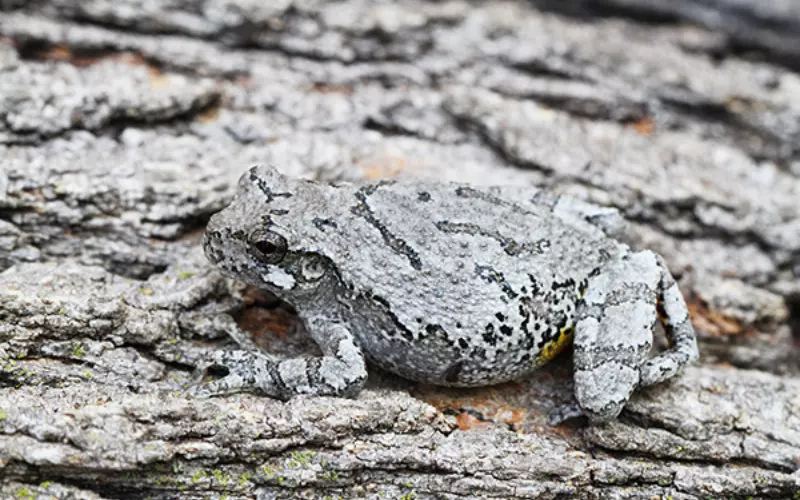
1. The grey tree frog is a small amphibian in various parts of North America.
2. They are typically about 1.5 to 2 inches long, with smooth and slim bodies.
3. Gray tree frogs can change their colour depending on their environment, ranging from grey to green.
4. Their skin is covered in tiny bumps called warts that help them blend in with tree bark and leaves.
5. These frogs have large, round eyes that are gold or yellow.
6. They are excellent climbers well adapted to living in trees.
7. Gray tree frogs have sticky toe pads that allow them to cling to different surfaces easily.
8. These frogs are primarily nocturnal, meaning they are active during the night.
9. They have a unique call that sounds like a high-pitched trill or chirp, which they use to communicate with other frogs.
10. Gray tree frogs mainly feed on insects, spiders, tiny snails, and other small frogs.
11. They have a long lifespan for a frog, often living up to 8 years in the wild.
12. During the winter, grey tree frogs hibernate by burying themselves in leaf litter or beneath tree bark.
13. These frogs can freeze partially when temperatures drop, which helps them survive in colder climates.
14. Female grey tree frogs lay their eggs in water, often in small ponds or wetlands.
15. The tadpoles of grey tree frogs undergo a metamorphosis, gradually developing legs and lungs until they become fully-formed frogs.
Can we keep Gray Tree Frog as our Pet?
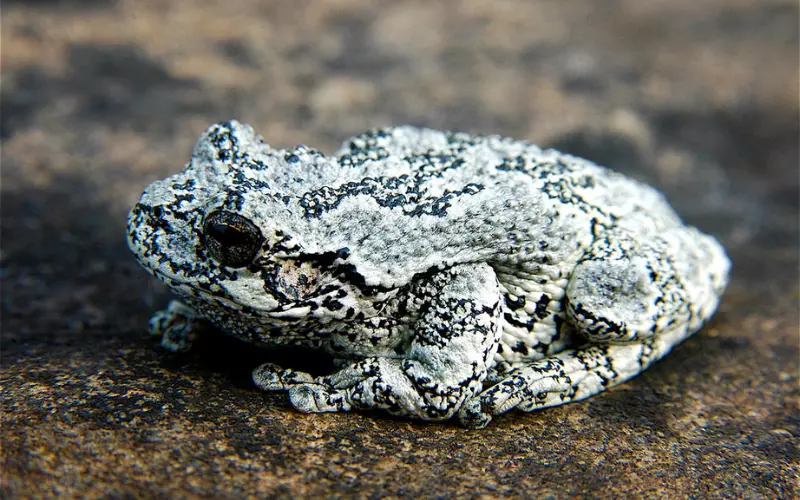
The Gray Tree Frog is not always the best choice as a pet. It is a wild animal; keeping it as a pet can be difficult and unsuitable for the frog. It is best to leave them in their natural habitat, where they can live happily.
The Gray Tree Frog is a small amphibian native to North America. It has a unique greyish-green colour that helps it blend into its surroundings. They are known for their ability to climb trees and loud calls during mating season. They have delicate and sensitive skin, which can be easily harmed if not properly cared for.
Unfortunately, the Gray Tree Frog is facing some threats in the wild, which has led to its population decline in some areas. Habitat loss, pollution, and introduction non-native species have all contributed to their decline. If the Gray Tree Frog were to become extinct, it would significantly lose our natural environment.
Therefore, we need to help protect and preserve their natural habitats. We should not try to keep them as pets, as this can disrupt their natural behaviour and survival. Instead, we can learn about them and appreciate their beauty by observing them in the wild or visiting nature centres and educational programs focusing on conservation efforts. Let’s do our part to ensure that the Gray Tree Frog and other animals can thrive in their natural homes.
Size of Gray Tree Frog

The Gray Tree Frog is a small animal found in the eastern parts of the United States and Canada. It is one of the most minor types of frogs, growing about 1.25 to 2 inches long. This means they can fit comfortably in the palm of your hand!
Despite their small size, Gray Tree Frogs are known for their incredible ability to camouflage. Their grey or greenish-brown skin helps them blend perfectly with their surroundings, such as trees and rocks. This camouflage protects them from predators, keeping them safe and hidden.
Both male and female Gray Tree Frogs have the same size and appearance, but there is one slight difference. Females tend to have a slightly larger body, while males have a more prominent vocal sac. This vocal sac is essential to their mating call, helping the males attract females by producing a loud and unique sound.
The Gray Tree Frog is a small creature that can be easily overlooked due to its size, but don’t be fooled by its tiny frame! With its impressive camouflage and distinctive vocalizations, this little frog has found its place in the vast world of nature.
Habitat of Gray Tree Frog
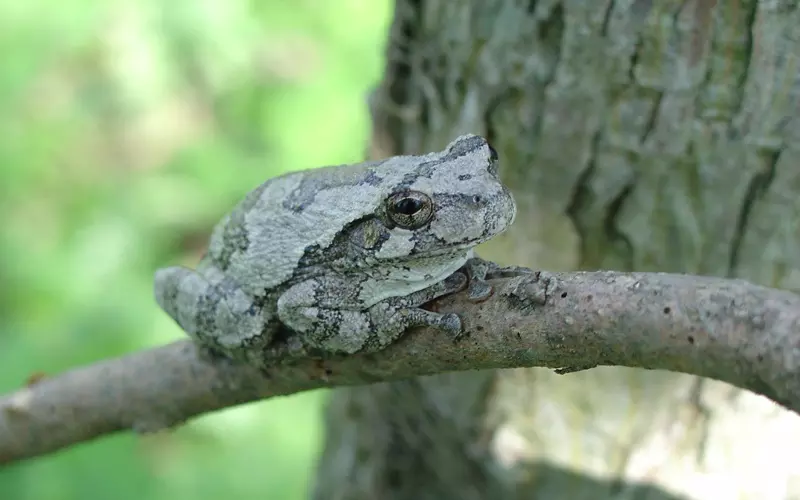
The grey tree frog is a fascinating creature with a unique habitat. It can be found in eastern North America, from Canada to Florida. These little frogs prefer to live in forests and woodland areas with plenty of trees to climb and hide in.
A critical aspect of the grey tree frog’s habitat is the presence of trees. These frogs have special suction-like pads on their toes that help them cling onto tree branches. They can climb up high into the canopy, where they can hop from leaf to leaf in search of insects to eat. The tree branches also provide them with protection from predators and a safe place to sleep during the day.
Another essential feature of the grey tree frog’s habitat is the availability of water sources. Even though they spend most of their time in trees, these frogs need water to lay their eggs. They prefer to breed in small, temporary ponds or shallow pools of water. These areas are ideal for their eggs to develop and hatch into tadpoles, eventually growing into adult frogs. Having water nearby also gives the grey tree frog a place to cool off and rehydrate during hot summer days.
The grey tree frog’s habitat consists of forests with various trees to climb and hide in and nearby water sources for breeding and survival. These habitats play a crucial role in the survival and well-being of these fascinating frogs, allowing them to thrive in their natural environment.
Evolution of Gray Tree Frog

The Gray Tree Frog is a fascinating animal that has undergone an interesting evolutionary journey. They belong to the family Hylidae, known for its tree-dwelling frogs. Over millions of years, these small creatures developed unique features to help them adapt to their changing environment.
The evolution of the Gray Tree Frog can be traced back to when their ancestors were aquatic frogs. These frogs lived in bodies of water, resembling typical tadpoles. However, as their environment changed, they had to adapt to survive. Gradually, these frogs preferred living in trees rather than water. This led to the development of long and slender toes with adhesive pads, enabling them to cling to branches and other surfaces easily.
Another exciting aspect of the grey tree frog’s evolution is its ability to change colour. These frogs were initially grey or green, depending on their surroundings. However, as they moved higher up in the trees, they needed a better way to camouflage themselves. This resulted in the development of unique skin pigments that allow them to change their colour to match their environment. This remarkable adaptation helps them hide from predators and gives them a better chance of survival.
The Gray Tree Frog has undergone a remarkable evolutionary journey. From their aquatic origins, they developed unique features like long toes and adhesive pads to help them live in trees. They also developed the ability to change colour to blend in with their surroundings. These adaptations have allowed them to thrive in their changing environment and continue to survive.
Classification of Gray Tree Frog

The Gray Tree Frog is a small animal that belongs to the Hylidae family. This family includes many different species of frogs. The scientific name for the Gray Tree Frog is Hyla versicolor. It is often called a tree frog because it spends most of its life in trees.
The Gray Tree Frog is known for its ability to change its colour. It can range from a grey or greenish-grey colour to a bright green colour. This allows it to blend in with its surroundings and hide from predators. It has a small, stocky body with smooth skin and a rounded snout. It also has large adhesive pads on its fingers and toes that help it grip onto tree branches.
The Gray Tree Frog can be found in forested areas throughout the eastern United States and parts of Canada. It prefers moist habitats like swamps, marshes, and wooded areas near rivers and ponds. It is a nocturnal animal, which means it is most active at night. During the day, it rests in tree branches or other hidden spots.
The Gray Tree Frog is a fascinating creature from the Hylidae family. It is known for its ability to change colour and climb and grip onto tree branches. It is found in forested areas of the eastern United States and Canada and prefers moist habitats.
Different Types of Gray Tree Frog
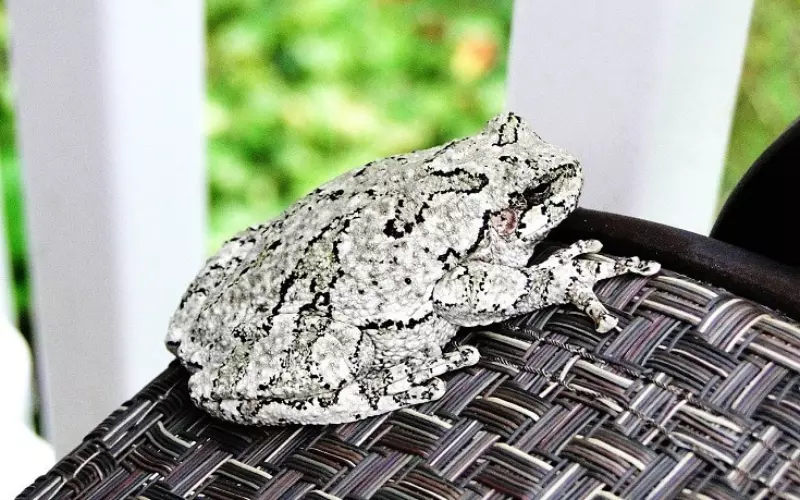
1. Gray tree frogs belong to the Hyla versicolor species and are known for their unique ability to change their colour from grey to green or brown, depending on their surroundings, as camouflage.
2. They are small-sized amphibians, measuring about 1.5 to 2 inches long, making them ideal to study and observe up close.
3. These frogs are commonly found in North America, primarily in areas with trees, such as forests, woodlands, and even suburban gardens.
4. Unlike other frog species, grey tree frogs are excellent climbers and can be seen perched on branches or even on the sides of buildings.
5. They have large adhesive toe pads that help them cling to surfaces, enabling them to climb vertical objects like tree trunks or glass windows effortlessly.
6. Gray tree frogs are nocturnal creatures, which means they are most active during the night. They would spend their days hiding in cool, shady areas to avoid heat and dehydration.
7. Their diet mainly consists of small insects, including flies, mosquitoes, ants, and beetles. They use their sticky tongue to catch prey, making them efficient hunters.
8. Male grey tree frogs have a distinctive, melodic call, described as a short musical trill. They use this call to attract females during the breeding season.
9. These frogs transform from tadpoles to fully formed frogs, transitioning from aquatic life to terrestrial. They lay their eggs in shallow water bodies like ponds or pools.
10. Gray tree frogs are essential to the ecosystem as predators and prey. They control insect populations by feeding on them while serving as a food source for larger animals like birds and snakes.
Geographical Presence of Gray Tree Frog
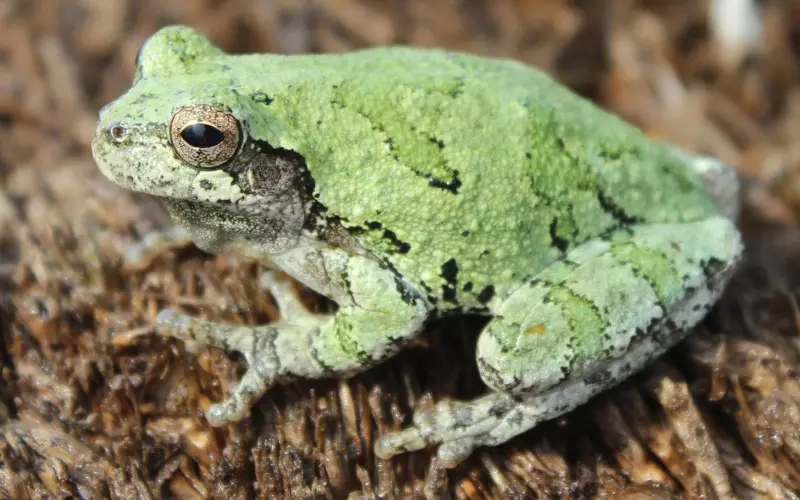
The Gray Tree Frog is a small amphibian in the Eastern United States and parts of Canada. This region is known as the native range of the Gray Tree Frog. These frogs are commonly found in forests, swamps, and gardens where they can easily camouflage themselves among the trees and plants.
Gray Tree Frogs are not found in other regions such as Europe, Asia, or South America. They are specifically adapted to the habitats of the Eastern United States and Canada. These frogs prefer areas with trees and shrubs to climb and hide during the day. Other regions with different climates and ecosystems do not provide suitable conditions for the Gray Tree Frog to live and thrive.
It is interesting to note that the grey tree frog can change its colour remarkably. This helps it blend in with its surroundings and avoid predators. Their skin can range from green to grey, depending on their environment. This natural camouflage makes them difficult to spot, especially during the daytime when they are most active.
The Gray Tree Frog is found in the Eastern United States and parts of Canada. It prefers habitats with trees and shrubs where it can easily hide and climb. These frogs are not found in other regions of the world as they are specifically adapted to the conditions of their native range. Their ability to change colour also helps them blend in with their surroundings for better protection.
Scientific Name of Gray Tree Frog
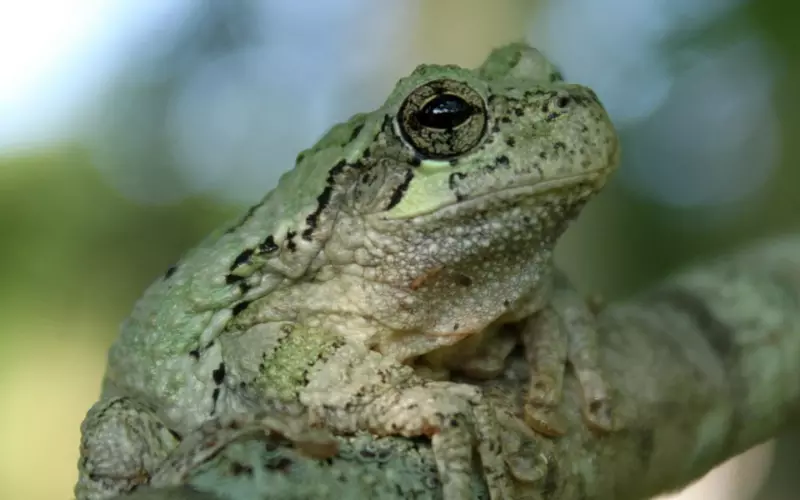
The scientific name for the Gray Tree Frog is Hyla versicolor. It belongs to the Hylidae family and is a small-sized amphibian found in North America. With its scientific name, scientists can study and understand this species better.
The Gray Tree Frog, scientifically known as Hyla versicolor, can change its colour to match its surroundings. It usually ranges from grey to light green, making it harder for predators to spot them. This adaptation helps them stay safe in their natural habitat.
These frogs are commonly found in forests, woodlands, and wetlands, as they prefer to live near bodies of water where they can lay their eggs. They are excellent climbers with adhesive toe pads that help them grip onto trees and plants. Gray Tree Frogs use their loud, croaking calls at night to communicate with other frogs and attract mates.
The scientific name Hyla versicolor is given to the Gray Tree Frog. This species can change its colour and is well-adapted to living in trees. By understanding its scientific name, scientists can conduct further research about these fascinating amphibians.
Diet of Gray Tree Frog

Like many other animals, the grey tree frog has a special diet that helps it stay healthy and strong. These frogs are carnivores, which means they eat other animals. Their diet mainly consists of insects, such as crickets, beetles, and ants.
When the grey tree frog is hungry, it uses its long, sticky tongue to catch its prey. It waits patiently on a branch or a leaf, and when an insect comes by, the frog leaps into action! Its tongue shoots out and quickly grabs the insect before it knows what happened.
These frogs also have a clever trick when it comes to finding food. They can change their colour to blend in with their surroundings. So, if they sit on a green leaf, they might turn green themselves, making it harder for insects to see them. This makes it easier for the grey tree frog to sneak up and catch its meal.
The diet of a grey tree frog consists of insects like crickets, beetles, and ants. They use their long, sticky tongue to catch their prey and can change their colour to blend in with their surroundings. The grey tree frog can stay healthy and thrive in its habitat by eating these tiny creatures.
Locomotion of Gray Tree Frog
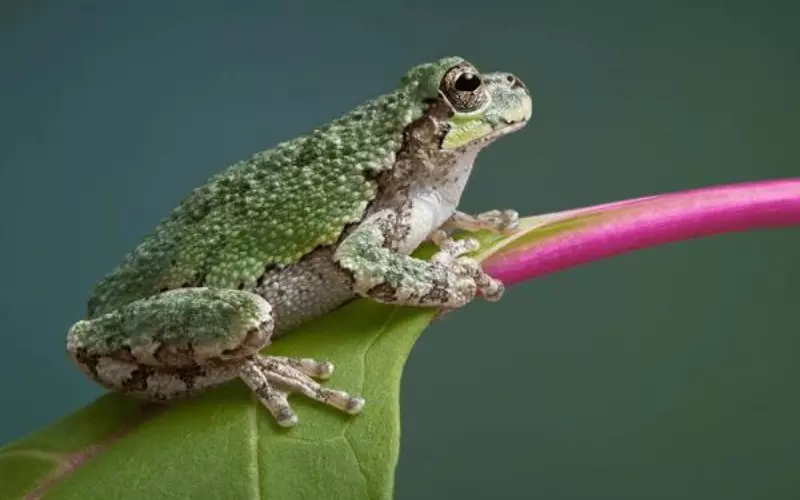
Grey tree frogs have a unique way of moving around called locomotion. They have a unique ability to climb trees and jump from one branch to another. To do this, they use their long, sticky toes that help them cling to surfaces. This allows them to navigate through the branches and leaves of trees easily. Grey tree frogs also have strong legs that help them jump long distances. They can leap up to 20 times their body length, which is impressive for a small creature.
When walking on the ground, grey tree frogs use a different technique. They have a bouncy and hopping way of moving. This is because their hind legs are longer and more potent than their front legs, allowing them to push off the ground and cover more distance with each jump. They can move quickly and efficiently this way, making catching insects for their meals easier.
Grey tree frogs have tremendous locomotion skills. Whether climbing trees with sticky toes or hopping and jumping on the ground, these little frogs are masters of movement.
Social and Sexual Behaviour of Gray Tree Frog

Grey tree frogs are fascinating creatures when it comes to their social and sexual behaviour. These tiny amphibians are pretty friendly and can often be found in groups, especially during mating season. They communicate using different calls, which vary depending on their intentions or feelings. These calls act like a language that helps them find a mate or warn other frogs about potential danger.
During the breeding season, grey tree frogs embark on a journey to find a suitable mate. Male frogs are the ones that make the most noise with their loud, repetitive calls. They do this to attract the attention of female frogs and compete with other males. Female frogs listen to these calls and choose their partner based on the quality of the call. Once males and females have found each other, they perform a unique behaviour called amplexus. This is when the male clasps onto the female’s back and fertilizes her eggs as she lays them.
Overall, grey tree frogs are friendly creatures that use their unique calls to communicate and find suitable mates. They follow an interesting breeding ritual that involves loud calls from males and the selection of partners based on these calls. This behaviour ensures the survival of their species and showcases the fantastic ways animals interact and reproduce in nature.
Reproduction and Lifecycle of Gray Tree Frog

The Gray Tree Frog, a small and fascinating amphibian, goes through an interesting life cycle. These amazing creatures reproduce by laying eggs in water. The female frog lays jelly-like eggs in a shallow pond or marsh, where they cling to plants or float on the water’s surface. Once the eggs are laid, it usually takes about a month for them to hatch.
When the eggs hatch, tiny tadpoles emerge. These tadpoles have gills and swim using their tails. They eat algae and other tiny water organisms. As they grow, they go through a transformation called metamorphosis. During this process, their bodies change and adapt. They develop legs, and their gills are replaced with lungs. This change prepares them to live on land.
After a few months, the tadpoles developed into fully-formed grey tree frogs. They climb out of the water and onto land to begin their adult lives. These adult frogs have green or grey skin, perfect for blending in with trees and leaves. They are also skilled climbers, using their sticky toe pads to cling onto branches and surfaces.
The Gray Tree Frog goes through a remarkable life cycle. Starting as eggs in water, they transform into tadpoles with gills and eventually become adult frogs equipped for life on land. Observing this change process is fascinating and helps the Gray Tree Frog survive and adapt to different environments.
Threats to Gray Tree Frog
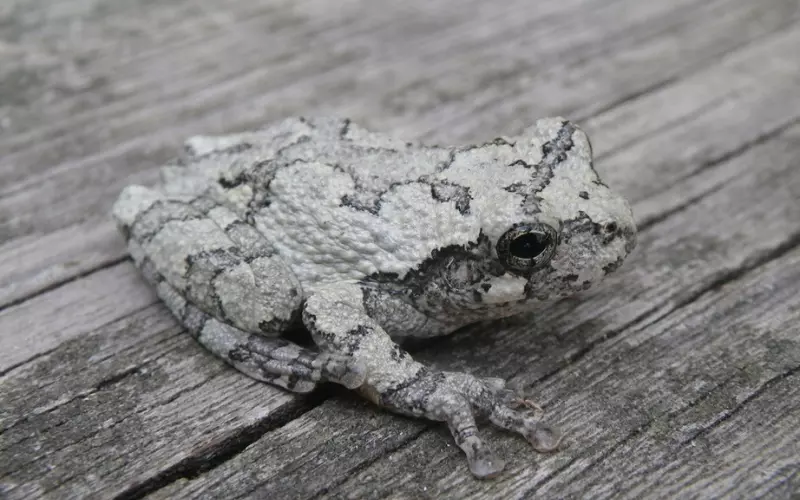
The grey tree frog is facing several threats that could harm its population. One of the biggest threats is habitat loss. Trees are being cut down to make space for buildings and roads, which means there are fewer trees for the grey tree frog to live in. Without enough trees, the frogs have more difficulty finding food and places to hide from predators.
Another threat to the grey tree frog is pollution. When factories release chemicals into the air and water, it can harm the frogs and the insects they eat. Pollution can make the water dirty and unsafe for the frogs to live in. It can also make the air toxic, making it harder for the frogs to breathe.
Climate change is also a significant threat to the grey tree frog. As the Earth’s temperature gets warmer, it can disrupt the frog’s hibernation patterns. The frogs rely on the changing seasons to know when to hibernate and when to wake up. But with warmer temperatures, their internal clocks get confused, leading to unhealthy frogs that cannot reproduce and survive.
To help protect the grey tree frog, people need to take action. Planting more trees and protecting their habitats can provide safe homes for the frogs. Reducing pollution using clean energy sources and being mindful of waste can also make a big difference. And addressing climate change by reducing greenhouse gas emissions can help ensure the grey tree frog’s survival for future generations.
The population of Gray Tree Frog
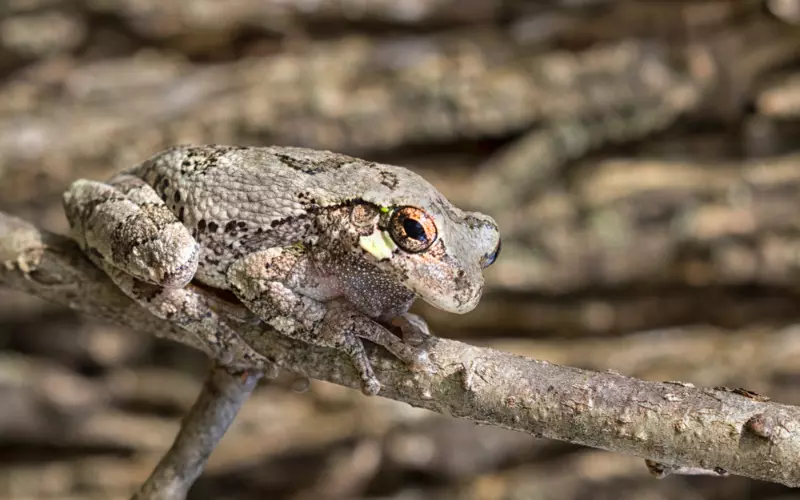
The Gray Tree Frog animal population is believed to be relatively abundant. It is estimated that there are around 10 million Gray Tree Frogs in North America. These tiny amphibians are found in many habitats, including forests, swamps, and suburban areas. They are known for their excellent camouflage, allowing them to blend in with the trees and plants they live in.
If the Gray Tree Frog were to become extinct, it would be a sad environmental loss. These frogs play an essential role in the ecosystem as they eat insects, which helps to control their populations. In recent years, there have been concerns about declining frog populations worldwide due to habitat loss, pollution, and disease.
To prevent the extinction of the Gray Tree Frog and other amphibians, humans need to protect their habitats by preserving forests and wetlands. Additionally, we should be mindful of our environmental impact and work towards reducing pollution. By taking these actions, we can ensure that future generations will still have the opportunity to glimpse the fascinating Gray Tree Frog.
Conclusion
The Gray Tree Frog is a fascinating creature with a rich history and many interesting facts. This tiny amphibian is known for its ability to change colours, making it difficult to spot in its natural habitat. It can be found in various parts of North America, such as the United States and Canada. The Gray Tree Frog is known for its unique calls, which sound like a soft trill or quack.
This animal is relatively small, with adults reaching a size of about 1.5 inches to 2 inches in length. It has smooth and mottled grey or greenish-grey skin, which serves as camouflage in the trees. The Gray Tree Frog prefers to live in wooded areas near ponds or swamps, where it can climb trees and hide among the branches.
Regarding classification, the Gray Tree Frog belongs to the family Hylidae and the genus Hyla. There are two main species of Gray Tree Frog, namely the Eastern Gray Tree Frog and the Cope’s Gray Tree Frog. Both species share similar characteristics and behaviours, with slight differences in appearance and habitat preferences.
The Gray Tree Frog is a captivating little creature with a long history and intriguing features. Its ability to change colours, unique calls, and preference for tree habitats make it a remarkable member of the animal kingdom. By learning more about animals like the Gray Tree Frog, we can develop a greater appreciation for the diversity and beauty of nature.
Frequently Asked Questions about Gray Tree Frog (FAQ’s)
What is a Gray Tree Frog?
The Gray Tree Frog (Hyla versicolor) is a small arboreal frog species native to North America.
Where can Gray Tree Frogs be found?
Gray Tree Frogs can be found in the eastern and central parts of the United States and southeastern Canada.
What do Gray Tree Frogs eat?
Gray Tree Frogs primarily feed on insects, such as beetles, ants, flies, and spiders.
How big do Gray Tree Frogs get?
Gray Tree Frogs typically grow to be around 1.5 to 2.3 inches (3.8 to 5.8 cm) in length.
Are Gray Tree Frogs endangered?
No, Gray Tree Frogs are not currently considered endangered. Their populations are stable.
Do Gray Tree Frogs change colour?
Yes, Gray Tree Frogs can change their colour. They can range from grey to green, depending on their surroundings.
Can Gray Tree Frogs climb trees?
Gray Tree Frogs are excellent climbers who spend most of their time in trees or other vegetation.
How do Gray Tree Frogs reproduce?
Gray Tree Frogs reproduce by laying their eggs in bodies of water, such as ponds, marshes, or temporary pools.
What is the lifespan of a Gray Tree Frog?
Gray Tree Frogs can live up to 8 to 10 years in the wild.
Are Gray Tree Frogs poisonous?
No, Gray Tree Frogs are not poisonous. They do not possess any toxins or secretions that can harm humans.
Can Gray Tree Frogs croak?
Gray Tree Frogs are known for their distinct call, which sounds like a short trill or high-pitched chirping.
Are Gray Tree Frogs nocturnal?
Gray Tree Frogs are primarily nocturnal creatures, meaning they are most active at night.
Do Gray Tree Frogs hibernate?
Yes, Gray Tree Frogs hibernate during the winter. They bury themselves in leaf litter or loose soil to protect themselves from freezing temperatures.
Can Gray Tree Frogs be kept as pets?
Yes, Gray Tree Frogs can be kept as pets. However, they require specific care and an environment miming their natural habitat.
How can I attract Gray Tree Frogs to my garden?
To attract Gray Tree Frogs to your garden, you can provide suitable vegetation a minor water feature and avoid using pesticides that could harm these amphibians.
Are Gray Tree Frogs beneficial to the environment?
Gray Tree Frogs are beneficial as they help control insect populations, including pests that may damage crops or gardens.

Hey there, I’m Tyler Swan! I worked as an Animal Care Specialist at Neuralink and completed my education at the University of California, Davis. Animals have always fascinated me, so I chose to study and work with them.
In my job, I take care of animals and make sure they’re healthy and happy. I’ve had cool roles like Lab Manager and Senior Research Assistant at Mitloehner Lab, where I’ve learned much about animals.
I’m not just about work, though. I love animals so much that I write articles about them! I enjoy sharing fun and interesting facts about our furry and feathered friends.
If you ever want to know more about animals or need help with animal info, ask! I’m here to make learning about animals easy and fun, just like chatting with friends.

